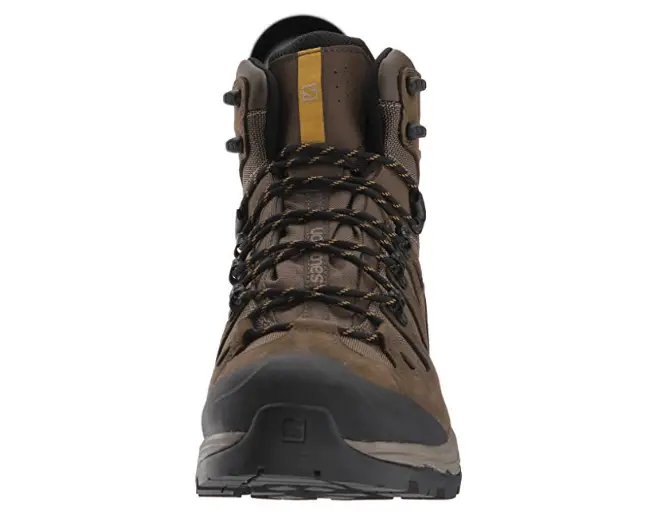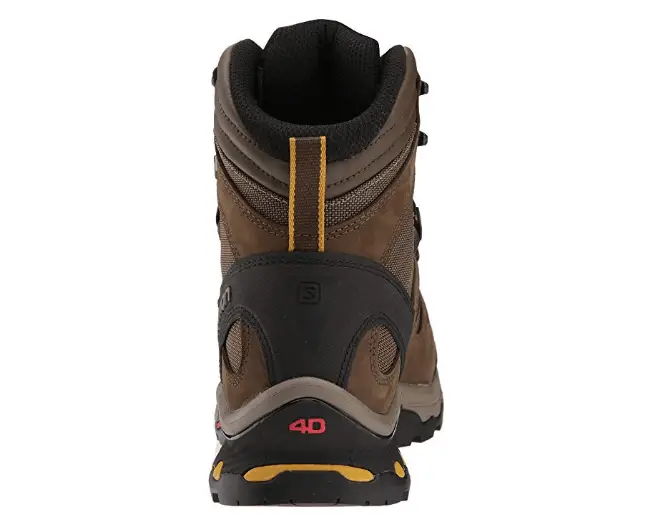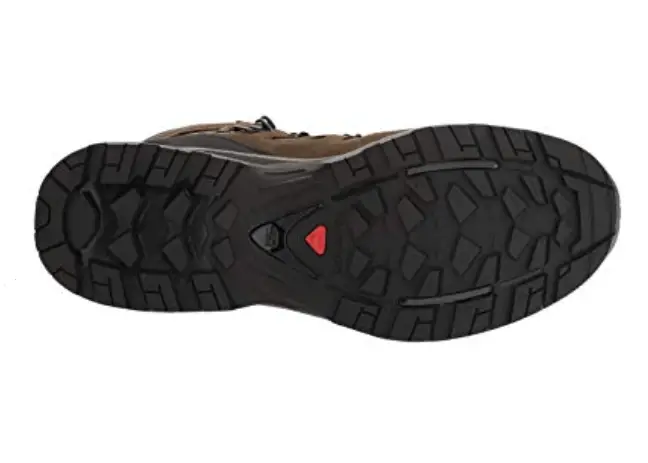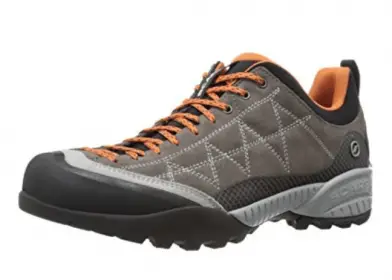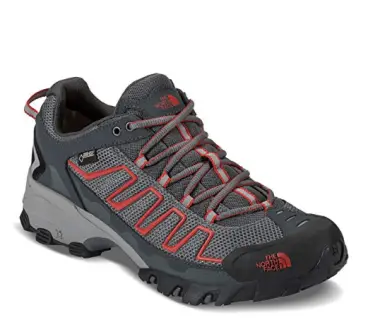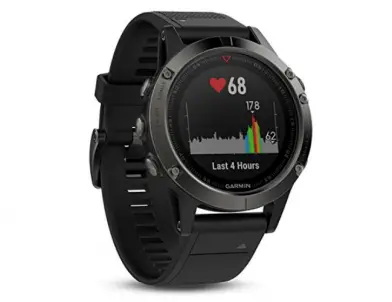Salomon Quest 4D 3 GTX
Salomon Quest 4D 3 GTX Review Facts
The Salomon brand has long been associated with the sport and love of hiking, especially in rough terrains and over long distances. Their Quest 4D series of hiking boots have often proved to be a great asset on the trail, and the Quest 4D 3 GTX hiking boot aims to be the latest edition in this brand's tradition. Designed for those who go beyond the occasional weekend hike, these boots were certainly made for more than just walking.
Editor's Pros & Cons
Pros
- Comfortable with little break in time
- Good stability
- Water-resistant
Cons
- Seams not as durable as expected
- Not suitable for warm or hot environments
- No real wide-width or narrow-width options for sizing
- Not suitable for the average hike – better for long arduous trekking
Positive
- These boots are tough yet lightweight.
- Salomon does not sacrifice comfort to provide good protection with these boots.
- The upper performs well in both dry and wet conditions.
- The tread is great on rocky terrain.
- There is a comfortable amount of flex in the ankle without skimping on support.
- Reviewers have been impressed with how these hold up on long and rugged hikes.
- For many buyers, these boots have lasted years of heavy use.
- A high level of craftsmanship is apparent.
- The long laces give you some flexibility and options in how you want to lace them.
- Most reviewers have been satisfied with the fit and claim little to no break-in time was required.
- The upper keeps your feet warm in cold conditions but has enough breathability to not overheat your feet on warmer days.
- Reviewers are satisfied with how these grip on snow, and they work decently with crampons, too.
- The design promotes stable footing on rough terrain and steep ascents and descents.
- Overlays on the front and back keep your toes and heels protected.
- It's easy to adjust the laces from toe to heel and up the ankle.
- There are very few complaints about hot spots or blisters.
Negative
- The grip doesn't hold up very well on hard, wet surfaces.
- Most buyers notice the tread beginning to deteriorate after a year or so of regular use.
- The laces tend to loosen or untie if not double-knotted.
- There are a few complaints about the long-term durability.
- These boots are expensive. While many buyers say they are worth the price, several are disappointed in the overall durability.
- There is limited availability in some sizes.
- If you have high arches, these can be a little tough to get on.
- The fit works best for narrow to average-width feet. People with wide feet may find it hard to find the right size.
- One reviewer notes that the materials are not tough enough for sidehilling.
- The padding on the tongue can cause some initial discomfort.
- These are not ideal for people with narrow heels.
- There are several quality control complaints about poor gluing and insufficient waterproofing.
Reviewmeter
The Reviewmeter shows you an overall score that you can easily refer to. The highest rating is 10 (100% positive feedback)
Of the 519 reviews we found in total,
14% were negative, and
86% were positive.
Outsole
These hiking boots from Salomon feature a tough rubber outsole that has a surprisingly moderate amount of give. This allows the boot to flex more easily, especially in the forefoot area, which in turn makes it easy to adjust your step as needed over a wide range of terrains. The outsole also has tread that is designed with Contagrip rubber material for added traction and control overall.
Midsole
Perhaps one of the most notable things about this particular hiking boot is the level of overall comfort that it provides. One of the main reasons why is the dual composition mid-sole material combined with the removable Ortholite footbeds. The mid-sole area is comprised of EVA material of two separate densities that combine together to create a spring-like cushioning that is both firm and light so that each step is relatively comfortable. Add to that the breathable footbed liner, and you have a hiking shoe that actually feels lighter than it is, and more comfortable overall.
Upper
The upper portion of this hiking boot is made of a combination of nubuck leather and fabric material. It offers adequate protection from moisture and the occasional wade through a puddle, but it’s far from truly weatherproof. However, it does conform nicely to the foot over time, creating a comfortable yet snug fit, the more you wear it. The lacing eyelets are constructed out of a lightweight plastic material that is surprisingly strong and helps to keep the laces in place and prevent the fraying that can sometimes occur with metal eyelets on other boots. Finally, the cushioned tongue offers a good deal of protection from debris, dirt and the grime commonly found on the trail.
Breathability
This boot is surprisingly lightweight and breathable considering it’s overall weight and construction. The nubuck leather and nylon mesh panels in the upper portion combine nicely to create a generalized air flow throughout the shoe that is apparent even when the shoe becomes dirty. In addition, the Ortholite liner has a number of strategic holes near the toe area of the shoe, allowing for extra ventilation where most people need an extra boost.
Also read about childrens hiking boots
There is, of course, a limit to how well these boots allow the air to flow through them. Once they become dirty or waterlogged, their overall breathability does decrease remarkably fast. Thankfully, because of the nature of their upper portions, cleaning is often as simple as a quick wipe down with a damp cloth, rag, or sometimes even your hand. Once that is accomplished, ventilation is often back to normal.
Also read about childrens hiking boots
There is, of course, a limit to how well these boots allow the air to flow through them. Once they become dirty or waterlogged, their overall breathability does decrease remarkably fast. Thankfully, because of the nature of their upper portions, cleaning is often as simple as a quick wipe down with a damp cloth, rag, or sometimes even your hand. Once that is accomplished, ventilation is often back to normal.
Comfort
Perhaps the area where these boots excel the most is in overall comfort. Numerous reviews commented on the fact that the combination of heel foam, a gusseted tongue, and the 4D advanced chassis located within the midsole area help to greatly reduce fatigue and foot stress while on the trail. The polyester lining in the shoe also helped to keep perspiration away from the feet, allowing them to stay relatively dry and blister free throughout most of the hike. In addition, the tongue itself is actually contoured to fit the instep area in a more natural way, and the boot is designed to hold the heel firmly in place while giving the toes plenty of wiggle room.
All that being said, the overall sizing of the boot did leave a bit to be desired. Whether to make them more cost-effective to produce, or merely because they haven’t found a need to make them, Salomon has decided to offer little in the way for sizing for people with wide or narrow feet. If you’re feet fall into the average category when it comes to width, you shouldn’t have a problem with these shoes. If they don’t, you might find them a bit uncomfortable to wear and use on a regular basis.
All that being said, the overall sizing of the boot did leave a bit to be desired. Whether to make them more cost-effective to produce, or merely because they haven’t found a need to make them, Salomon has decided to offer little in the way for sizing for people with wide or narrow feet. If you’re feet fall into the average category when it comes to width, you shouldn’t have a problem with these shoes. If they don’t, you might find them a bit uncomfortable to wear and use on a regular basis.
Style
Overall, these boots are fairly straightforward in their style, with very little variation from most other hiking boots on the market today. The coloration is often a mixture of muted and natural colors that can easily blend into both hiking and urban environments, allowing them to be worn in most casual or outdoor settings without too much trouble.
One style item that this boot does have that is not often seen is the slightly raised heel design. While it doesn’t really contribute much to the overall look, it does help quite a bit with the functionality of the boot and keep your feet from getting too tired. The raised heel design allows your foot to move a bit more naturally, and flex comfortably with each step.
One style item that this boot does have that is not often seen is the slightly raised heel design. While it doesn’t really contribute much to the overall look, it does help quite a bit with the functionality of the boot and keep your feet from getting too tired. The raised heel design allows your foot to move a bit more naturally, and flex comfortably with each step.
Durability
For the most part, the customers who used these boots found them to be durable and tough enough to withstand quite a few hiking trips or weekend trips to the campground. The treads were found to hold up under regular use quite well, and the upper portions only showed signs of minor abrasions and scuffs, even after scrambling over rocky terrain. They weren’t without their issues, however. Excessive wear and tear and fraying were often seen in the seam areas of the shoes, and the rand area often wore through faster than expected, especially in the toe and forefoot area of the shoe. These shoes from Salomon perform quite well in most hiking situations but aren’t really suitable for places where high durability or toughness are a requirement, such as construction sites or long-term trekking.
Protection
In a very real sense, these boots provide good overall protection from the elements and the environment. The Gore-Tex performance comfort membrane provides good protection overall from rain and the occasional stream or puddle, but we certainly wouldn’t recommend using these boots to fly fish your favorite stream. The heel and toe area have added shielding from abrasion with a sturdy rubberized material, and the outsole provides a good deal of protection overall from the rocks and debris often found on the trail itself.
Responsiveness
For the most part, customers found it easy to adapt their movements and work in many different terrains in these shoes. The specialized tread allowed for quick overall movements on steeper trails, and seasonal conditions such as mud or snow proved to be less of a problem than other hiking boots on the market today. In addition, the ability to easily flex the foot when needed and still have the support of an over the ankle hiking boot proved to be invaluable when moving over boulder fields or trails of loose debris.
Support
One of the nice things about the Salomon Quest 4D 3 GTX boot was that they provided a wealth of stability and support overall for the average hiker. The over the ankle design, firm fit on the heel and 4D chassis designed promoted a great deal of stability and comfort, even while moving over a variety of terrain.
Another feature that certainly added to the overall support was the insole area of the shoe. There was a removable liner included in the boot that was comprised of an OrthoLite material, which added a good amount of cushioning, and allowed for good overall weight distribution in the shoe itself. It was a nice added touch for most people, especially on longer hikes.
Another feature that certainly added to the overall support was the insole area of the shoe. There was a removable liner included in the boot that was comprised of an OrthoLite material, which added a good amount of cushioning, and allowed for good overall weight distribution in the shoe itself. It was a nice added touch for most people, especially on longer hikes.
Terrain
Due to the overall design of both the boot and the tread, these boots are a great choice for a variety of terrains. They function quite well on paved trails, ones made of dirt, moving through the foothills area, and even in some low mountainous areas. In truth, there are only a few terrains where these boots won’t work as well as desired, and those would be areas where there is a high water content, such as river, lakes, swamps or shorelines.
Price
When it comes to the overall affordability, however, these shoes aren’t exactly the most budget-friendly we’ve seen on the market. Prices range between $200 and $245 USD per pair, which places them in the moderate to a moderately expensive bracket for most budgets. That being said, they do offer a fairly good investment for an avid hiker. Their durability and overall construction do allow them to be used for quite a few seasons with adequate care and maintenance.
Traction
The tread on these shoes provides a welcomed amount of control on a wide range of ground surfaces. The lugs are fairly large and spaced far enough apart to allow for good grip and control, especially while scrambling down steep surfaces or over loose debris. In addition, the wider tread also allows for quick and easy cleaning, which can become a great asset on the trail.
Flexibility
Even with the 4D chassis, and the thicker outsole, these boots proved to be surprisingly flexible overall. The ankle and heel area of the shoe provided great support and stability overall, and the instep and toe box areas of the shoe allowed for a significant amount of play when necessary. In a very real sense, these boots allow your feet to move in a more natural way when traveling over a wide range of terrains.
Comparison to Other Brands
When it comes to hiking boots, the Salomon 4D 3 GTX proved to be a great overall contender when it came to weight, performance and overall durability. It performed better overall than most, beating out comparable brands such as the Scarpa Zodiac Plus GTX and the Adidas Terrex Scope High GTX without too much trouble. It often wasn’t seen as comfortable as the Hoka One One Tor Ultra Hi WP by most users, and there were quite a few choices that were a bit more budget-friendly overall. The general consensus, however, was that the Salomon Quest 4D 3 GTX shoe was a solid choice for most people.
Stability
Generally speaking, most people found these boots to be extremely stable and offer great protection from ankle rolls, twists, and overall instability. The over the ankle design and firm heel grip allows the foot and ankle to work well together and in a more natural way to help prevent injury overall. The contoured instep area, as well as the raised heel, also allowed for a comfortable and responsive fit overall, which adds to the overall stability of the boot. There are very few terrains where this boot proved to be a problem when it came to stability and support.
The Bottom Line
If you’re looking for a hiking boot that is lightweight, durable, fairly comfortable to wear, and can excel in a wide range of terrains, the Salomon Quest 4D 3 GTX is certainly a choice to put on your short list. The combination of a structured midsole area, firm grip heel, great overall ventilation, and a comfortable lightweight feel makes this a great choice for most mountainous or heavily forested hiking trails. The only real downsides that we came across was their lack of adequate sizing for wider or narrow feet, issues with the seam areas fraying, and the lack of true waterproofing. Overall though, these boots proved to be made for more than just walking, and at a respectable price.






